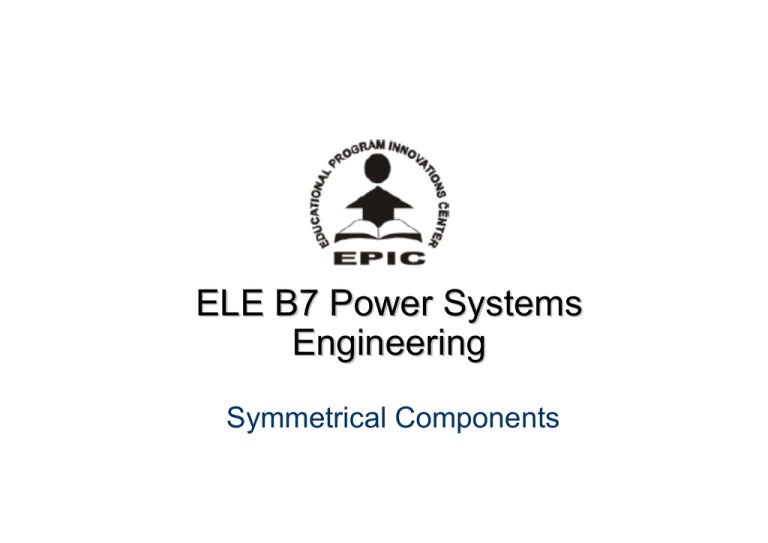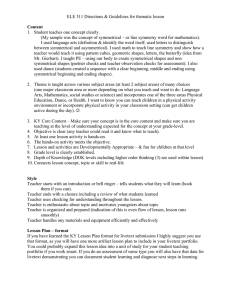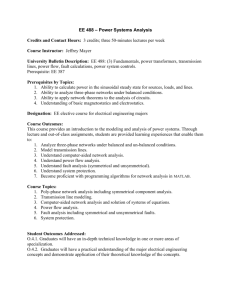Symmetrical Components
advertisement

ELE B7 Power Systems Engineering Symmetrical Components Analysis of Unbalanced Systems Except for the balanced three-phase fault, faults result in an unbalanced system. The most common types of faults are single lineground (SLG) and line-line (LL). Other types are double line-ground (DLG), open conductor, and balanced three phase. The easiest method to analyze unbalanced system operation due to faults is through the use of symmetrical components Slide # 1 Symmetrical Components The key idea of symmetrical component analysis is to decompose the unbalanced system into three sequence of balanced networks. The networks are then coupled only at the point of the unbalance (i.e., the fault) The three sequence networks are known as the – – – positive sequence (this is the one we’ve been using) negative sequence zero sequence Slide # 2 Symmetrical Components Balance Systems Unbalance Currents Unsymmetrical Fault IA IC IB zero sequence Zero Sequence Symmetrical components Unbalance System Sequence Currents Positive Sequence positive sequence Three balanced Systems Negative Sequence negative sequence Slide # 3 Symmetrical Components Assuming three unbalance voltage phasors, VA, VB and VC having a positive sequence (abc). Using symmetrical components it is possible to represent each phasor voltage as: VA VA0 VA VA B B VB V V V 0 B VC VC0 VC VC Zero Sequence Component Positive Sequence Component Negative Sequence Component Where the symmetrical components are: Slide # 4 Symmetrical Components The Positive Sequence Components ( VA , VB , VC ) Three phasors Equal in magnitude Displaced by 120o in phase Having the same sequence as the original phasors (abc) The Negative Sequence Components ( VA , VB , VC ) Three phasors Equal in magnitude Displaced by 120o in phase Having the opposite sequence as the original phasors (acb) 0 0 0 The zero Sequence Components ( VA , VB , VC Three phasors Equal in magnitude Having the same phase shift ( in phase) ) VA VC 120 o 120 o 120 o VB VA VB 120 o 120 o 120 o VC VB0 VA0 VC0 Slide # 5 Example VA VA0 VA VA VB VB0 VB VB V A0 VB 0 VC 0 Zero Sequence VA VC VC0 VC VC V A0 V A Positive Sequence VC 0 V A VC 120 o V A 120 o VB VA VC 0 V A VB Unbalance Voltage Negative Sequence 120 o 120 o VC VB VB Synthesis Unsymmetrical phasors using symmetrical components Slide # 6 Sequence Set Representation Any arbitrary set of three phasors, say Ia, Ib, Ic can be represented as a sum of the three sequence sets Ia Ib Ic 0 Ia I b0 I c0 Ia I b I c Ia I b I c where I a0 , I b0 , I c0 is the zero sequence set I a , I b , I c is the positive sequence set I a , Ib , I c is the negative sequence set Slide # 7 Conversion Sequence to Phase Only three of the sequence values are unique, I0a , I a , I a ; the others are determined as follows: = 1120 2 3 0 3 1 I0a I0b I0c (since by definition they are all equal) I b 2 I a I c I a I b I a I c 2 I a 0 1 1 1 1 I a 1 Ia 1 0 + 2 2 I I 1 I I 1 Ia b a a a 2 1 2 I I c 1 a Slide # 8 Conversion Sequence to Phase Define the symmetrical components transformation matrix 1 1 1 2 A 1 1 2 0 0 I I a Ia Then I I b A I a A I A I s I c I a I Slide # 9 Conversion Phase to Sequence By taking the inverse we can convert from the phase values to the sequence values 1 Is A I 1 1 1 1 1 2 with A 1 3 1 2 Sequence sets can be used with voltages as well as with currents Slide # 10 Example If the values of the fault currents in a three phase system are: I A 150 45 I B 250 150 I C 100 300 Find the symmetrical components? Solution: VO Slide # 11 Example If the values of the sequence voltages in a three phase system are: Vo 100 V 200 60 V 100 120 Find the three phase voltages Solution: V A 200 60 100 120 100 V A 300 60 V B 1 240( 200 60 ) 1120( 100 120 ) 100 V B 300 60 VC 1120( 200 60 ) 1 240( 100 120 ) 100 VC 0 Slide # 12 Use of Symmetrical Components 1. The Sequence circuits for Wye and Delta connected loads Consider the following Y-connected load: I n I a Ib I c Vag I a Z y I n Z n Ia V ab Vag ( ZY Z n ) I a Z n I b Z n I c n ZY Ib Vbg Z n I a ( ZY Z n ) I b Z n I c ZY V ca Ic V an I n 3 I ao ZY Zn V bc Vcg Z n I a Z n I b ( ZY Z n ) I c Vag Z y Zn Vbg Z n V Z n cg Zn Z y Zn Zn Ia Z n Ib Z y Z n I c Zn Slide # 13 Vn Use of Symmetrical Components Vag Z y Zn Zn Zn Ia Z y Zn Z n Ib Vbg Z n V Z I c Z Z Z n n y n cg V Z I , V A Vs , I A I s A Vs Z A I s Z y 3Z n 1 0 A ZA 0 Vs A 1 Z A I s 0 Zy 0 0 0 Z y Slide # 14 Networks are Now Decoupled V 0 Z y 3Z n 0 Zy 0 V 0 0 V Systems are decoupled V V 0 ( Z y 3Z n ) I 0 V Zy I I ao Vao ZY Zo Zero Sequence Circuit Ia ZY n 3Z n Va 0 0 I 0 I Z y I Z Positive Sequence Circuit Zy I n Ia Va ZY n Z Negative Sequence Circuit Slide # 15 Y-connected load (Isolated Neutral): Ia I ao Vca ZY Ic Vao ZY Ib Zo Van Vab ZY ZY If the neutral point of a Y-connected load is not grounded, therefore, no zero sequence current can flow, and Zn Symmetrical circuits for Y-connected load with neutral point is not connected to ground are presented as shown: Zn Zero Sequence Circuit Ia Vbc n Va ZY n Z Positive Sequence Circuit Ia Va ZY n Z Negative Sequence Circuit Slide # 16 Delta connected load: The Delta circuit can not provide a path through neutral. Therefore for a Delta connected load or its equivalent Y-connected can not contain any zero sequence components. Vab Z I ab , Vbc Z I bc , Ia Vab Vca Z I ca Ib The summation of the line-to-line voltages or phase currents are always zero 1 ( Vab Vbc Vca ) Vab 0 0 3 and I ab Vca Vbc Ic n V ao Va Z Z I bc 1 ( I ab I bc I ca ) I ab 0 0 3 Therefore, for a Delta-connected loads without sources or mutual will be no zero sequence currents at the lines (There are some circulating currents may circulate inside a delta load and not seen at the zero sequence circuit). Ia Ia I ao Z Z / 3 n Zero Sequence Circuit I ca Z Positive Sequence Circuit Va coupling there cases where a the terminals of Z / 3 n Negative Sequence Circuit Slide # 17 Sequence diagrams for lines Similar to what we did for loads, we can develop sequence models for other power system devices, such as lines, transformers and generators For transmission lines, assume we have the following, with mutual impedances Ia Zaa a’ Ib Zaa b’ a b Zab Ic c n In Zan Zaa Z nn c’ n’ Slide # 18 Sequence diagrams for lines, cont’d Assume the phase relationships are Va V b Vc where Zs Zm Z m Zm Zs Zm Zm Ia Z m Ib Z s I c Z s self impedance of the phase Zm mutual impedance between the phases Writing in matrix form we have V ZI Slide # 19 Sequence diagrams for lines, cont’d Similar to what we did for the loads, we can convert these relationships to a sequence representation V A Vs ZI V Z A Is Z s 2Z m A 1 Z A 0 0 A Vs Vs 0 Zs Zm 0 I A Is A 1 Z A Is 0 0 Z s Z m Slide # 20 Sequence diagrams for lines, cont’d I ao a Therefore, Zo Zo Z s 2 Zm Van0 Z Zs Zm n Z Zs Zm a Where, Van 0 n Ia Z s Z aa Z nn 2 Z an Van Z m Z ab Z nn 2 Z an n a The ground wires (above overhead TL) combined with the earth works as a neutral conductor with impedance parameters that effects the zero sequence components. Having a good grounding (depends on the soil resistively), then the voltages to the neutral can be considered as the voltages to ground. a Z Van n Ia Van n a a Z Van n Slide # 21 Sequence diagrams for generators Key point: generators only produce positive sequence voltages; therefore only the positive sequence has a voltage source I ao Ia Z Ean Z go Va Z Va Vao 3Zn During a fault Z+ Z Xd”. The zero sequence impedance is usually substantially smaller. The value of Zn depends on whether the generator is grounded Slide # 22 Sequence diagrams for Transformers The positive and negative sequence diagrams for transformers are similar to those for transmission lines. The zero sequence network depends upon both how the transformer is grounded and its type of connection. The easiest to understand is a double grounded wyewye Z Z + Reference Bus Z- Reference Bus Z0 Reference Bus Slide # 23 Transformer Sequence Diagrams Slide # 24


